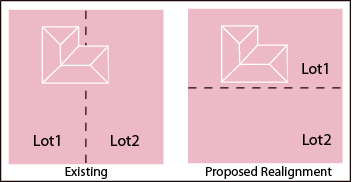Clause 62 of the VPP outlines exemptions from permit requirements for specified uses, works, subdivisions and demolition.
Clause 62.04 lists subdivision types that do not require planning permits. The exemption of most interest to private land owners relates to the ‘realignment of lot boundaries’. Separate exemptions are outlined for both urban and rural land.
In urban areas a subdivision which realigns the common boundary between two lots is exempt from acquiring a planning permit if all the land is in one urban zone and any of the following apply:
- Any lot that is reduced in area meets the minimum lot area and minimum dimensions (if any) specified for the zone. This does not apply if the area of the smaller lot is limited by a provision of this scheme, or by a condition of a planning permit.
- There is no minimum lot area specified for the zone, the area of the smaller lot is more than 230 square metres, and the area of either lot is reduced by less than 30 square metres.(emphasis added)
- There is no minimum lot area specified for the zone, the area of the smaller lot is 230 square metres or less, and the area of either lot is reduced by less than 5 percent or by less than 30 square metres, which ever is lesser.
- The new boundary coincides with a boundary fence that is more than five years old. This does not apply if all the land is in one ownership.
In a recent case, Rodney Aujard & Associates v Banyule CC [2010] VCAT 379, the Tribunal was asked to determine whether a boundary realignment met the requirements of bullet point 2 above and was therefore exempt from the need to acquire a planning permit.
The boundary realignment sought is summarised in the following illustration.

The Tribunal held that although the subdivision appeared to meet the tests contained in bullet 2 (above) the decision swayed on the interpretation of the words ‘a subdivision which realigns the common boundary between two lots’. In interpreting this phrase the Tribunal took the following position:
Clause 62.04 is an exception and it is intended to apply to the realignment of common properties not to the re-subdivision of lots. In my view, the realignment of a common boundary means that the existing boundary is moved. It does not mean that the common boundary is significantly altered in dimension or direction. In each case it will be a question of fact as to whether a proposal can be characterised as realignment of the common boundary between two lots or whether it is a re-subdivision of lots. The outcome must be assessed in the context of the existing situation
Applying this principle to the current case the Tribunal concluded that the proposed re-arrangement of the two subject lots involves such a substantial alteration of the direction of the common boundary that the proposal:
- should be characterised as a re-subdivision; and
- cannot take advantage of the Cl.62.04 exemption.”
Precisely what constitutes a ‘significant’ alteration in dimension or direction is unclear. Applicants seeking to take advantage of the exemptions in Clause 62.04 should be aware that the greater the extent of change the more likely you are to require a planning permit.
Seek Professional Advice
Information contained in this publication should be considered as a reference only and is not a substitute for professional advice. No liability will be accepted for any loss incurred as a result of relying on the information contained in this publication. Seek professional advice in specific circumstances.
Copyright
If you would like to reproduce or use for your own purposes any part of this publication please contact enquiries@clause1.com.au for assistance.
Clause1 Pty Ltd
Phone: 03 9370 9599
Fax: 03 9370 9499
Email: enquiries@clause1.com.au
Web: www.clause1.com.au
